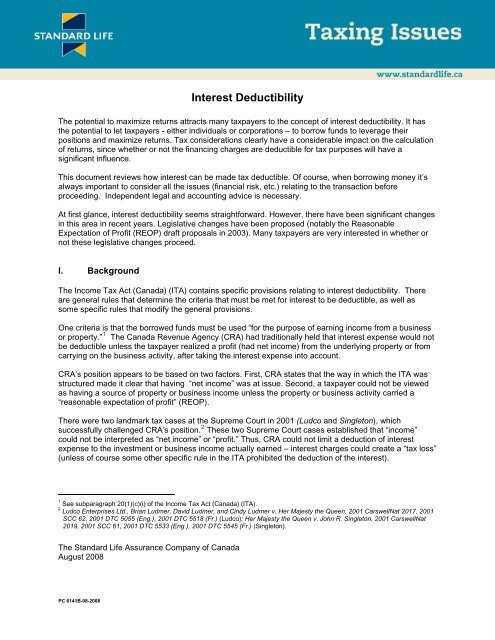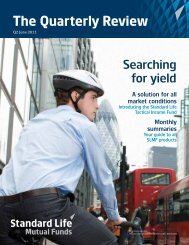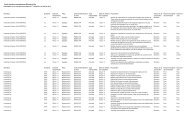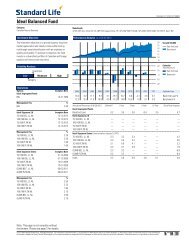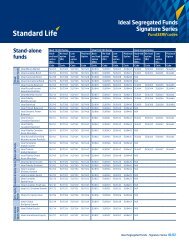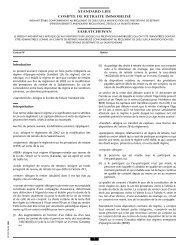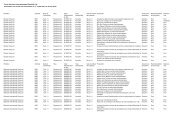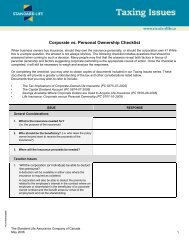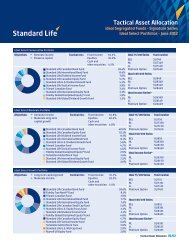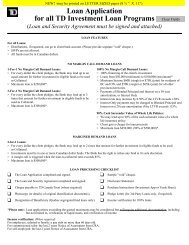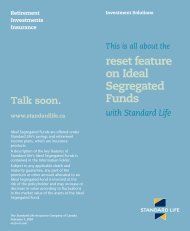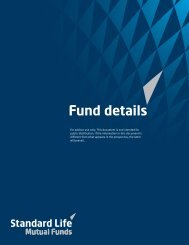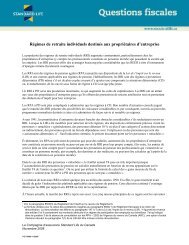Taxing Issues - Interest Deductibility - Standard Life
Taxing Issues - Interest Deductibility - Standard Life
Taxing Issues - Interest Deductibility - Standard Life
Create successful ePaper yourself
Turn your PDF publications into a flip-book with our unique Google optimized e-Paper software.
The <strong>Standard</strong> <strong>Life</strong> Assurance Company of Canada<br />
August 2008<br />
<strong>Interest</strong> <strong>Deductibility</strong><br />
The potential to maximize returns attracts many taxpayers to the concept of interest deductibility. It has<br />
the potential to let taxpayers - either individuals or corporations – to borrow funds to leverage their<br />
positions and maximize returns. Tax considerations clearly have a considerable impact on the calculation<br />
of returns, since whether or not the financing charges are deductible for tax purposes will have a<br />
significant influence.<br />
This document reviews how interest can be made tax deductible. Of course, when borrowing money it’s<br />
always important to consider all the issues (financial risk, etc.) relating to the transaction before<br />
proceeding. Independent legal and accounting advice is necessary.<br />
At first glance, interest deductibility seems straightforward. However, there have been significant changes<br />
in this area in recent years. Legislative changes have been proposed (notably the Reasonable<br />
Expectation of Profit (REOP) draft proposals in 2003). Many taxpayers are very interested in whether or<br />
not these legislative changes proceed.<br />
I. Background<br />
The Income Tax Act (Canada) (ITA) contains specific provisions relating to interest deductibility. There<br />
are general rules that determine the criteria that must be met for interest to be deductible, as well as<br />
some specific rules that modify the general provisions.<br />
One criteria is that the borrowed funds must be used “for the purpose of earning income from a business<br />
or property.” 1 The Canada Revenue Agency (CRA) had traditionally held that interest expense would not<br />
be deductible unless the taxpayer realized a profit (had net income) from the underlying property or from<br />
carrying on the business activity, after taking the interest expense into account.<br />
CRA’s position appears to be based on two factors. First, CRA states that the way in which the ITA was<br />
structured made it clear that having “net income” was at issue. Second, a taxpayer could not be viewed<br />
as having a source of property or business income unless the property or business activity carried a<br />
“reasonable expectation of profit” (REOP).<br />
There were two landmark tax cases at the Supreme Court in 2001 (Ludco and Singleton), which<br />
successfully challenged CRA’s position. 2 These two Supreme Court cases established that “income”<br />
could not be interpreted as “net income” or “profit.” Thus, CRA could not limit a deduction of interest<br />
expense to the investment or business income actually earned – interest charges could create a “tax loss”<br />
(unless of course some other specific rule in the ITA prohibited the deduction of the interest).<br />
1 See subparagraph 20(1)(c)(i) of the Income Tax Act (Canada) (ITA).<br />
2 Ludco Enterprises Ltd., Brian Ludmer, David Ludmer, and Cindy Ludmer v. Her Majesty the Queen, 2001 CarswellNat 2017, 2001<br />
SCC 62, 2001 DTC 5055 (Eng.), 2001 DTC 5518 (Fr.) (Ludco); Her Majesty the Queen v. John R. Singleton, 2001 CarswellNat<br />
2019, 2001 SCC 61, 2001 DTC 5533 (Eng.), 2001 DTC 5545 (Fr.) (Singleton).<br />
PC 6141B-08-2008
As a consequence of these cases, on October 31, 2003 CRA released its interpretation bulletin -<br />
Interpretation Bulletin IT-533 – <strong>Interest</strong> <strong>Deductibility</strong> and Related <strong>Issues</strong> - on this topic, incorporating the<br />
outcomes of the Singleton and Ludco decisions. Unless the legislation was changed, CRA had to abide<br />
by the positions taken at the Supreme Court level on the interpretation of the current legislation. (This of<br />
course assumes that CRA could not challenge the interest deductibility on some other basis, e.g., the<br />
General Anti-Avoidance Rule (GAAR), etc. Taxpayers and their advisors are currently awaiting the<br />
outcome of the Lipson case where CRA in fact applied GAAR. This case was heard at the Supreme<br />
Court in April 2008, but the judges have not yet rendered a decision as to whether the application of<br />
GAAR will be overturned. A decision is expected in the autumn of 2008. 3 )<br />
The Department of Finance (Finance) wanted to remedy an outcome that could result in a considerable<br />
loss of tax revenues to the government. On October 31, 2003 it introduced draft legislation, which<br />
contained significant revisions to the interest deductibility rules. Under these proposals, which are<br />
generally referred to as the “REOP draft proposals,” interest (and other expenses) could not be used to<br />
create a loss in the year, unless it was reasonable to expect that over the lifetime of the investment (or<br />
the carrying on of the business) a cumulative profit would be earned. It is not possible to predict how and<br />
when the government will proceed with these proposed changes.<br />
Quebec addressed this issue as well. Proposals contained in Quebec’s 2004 budget have actually been<br />
enacted. These are discussed in Section III below.<br />
The following discussion reviews current legislation. It focuses on borrowings incurred to acquire various<br />
investment products, and touches upon the requirements for borrowings incurred for business purposes.<br />
It briefly examines the REOP rules as well. Finally, it touches upon some planning opportunities.<br />
II. General Requirements for <strong>Interest</strong> <strong>Deductibility</strong><br />
The ITA contains specific conditions that must be met for interest to be deductible:<br />
• It must be paid or payable for the year (depending upon the method regularly followed by<br />
the taxpayer for computing income);<br />
• There must be a legal obligation to pay the amount;<br />
• The amount must be reasonable, and;<br />
• The borrowed money must be used to earn income from a business or property (other<br />
than to earn exempt income or to acquire a life insurance policy). 4<br />
See Section IV for specific rules relating to the acquisition of life insurance products (segregated funds,<br />
annuities and life insurance).<br />
The ITA does not contain a definition of “interest.” However, CRA considers an amount to be “interest” if it<br />
meets the following criteria:<br />
• The amount is calculated on a day-to-day basis;<br />
• The amount is calculated on a principal sum (or a right to a principal sum), and;<br />
• The amount represents compensation for the use of the principal sum (or the right to the<br />
principal sum). 5<br />
3 Supreme Court of Canada, Court File # 32041<br />
4 See paragraphs 20(1)(c)(i), (ii) of the ITA.<br />
5 See paragraph 1 of Interpretation Bulletin IT-533 – <strong>Interest</strong> <strong>Deductibility</strong> and Related <strong>Issues</strong> (IT-533), dated October 31, 2003.<br />
The <strong>Standard</strong> <strong>Life</strong> Assurance Company of Canada<br />
August 2008<br />
2
We will now review each of the four specific conditions:<br />
(a) <strong>Interest</strong> must be paid or payable for the year<br />
Taxpayers who use a cash method for calculating income would deduct interest on a cash basis. Those<br />
who use the accrual basis would deduct interest on an accrual basis. However, in the case of compound<br />
interest, this may only be deducted when paid, even for taxpayers otherwise using the accrual method. 6<br />
(b) Legal obligation to pay the amount<br />
There must be a legal obligation to pay the amount. Generally this means that the taxpayer must be<br />
bound under the obligation. The creditor must be able to seek legal recourse in the event of non-payment.<br />
A Federal Court of Appeal case, Shell (FCA), contains a lengthy analysis of interest deductibility. On the<br />
legal obligation issue, the judge in this case stated, “there is no such thing as a deduction for money paid<br />
voluntarily; there must be a legally recognizable duty to pay.” 7 He also made the point that a payment<br />
may look like interest, but may in fact be a distribution of profits, or a payment on account of principal. He<br />
did not consider such payments to be interest. 8<br />
Taxpayers are best served when there is a document formalizing the loan and containing all relevant<br />
provisions (e.g., repayment, how the interest is calculated, etc.). Where there is no documentation, the<br />
taxpayer may not be able to substantiate that there was indeed a legal obligation to pay the amount.<br />
(With a policy loan, the insurance contract, or other relevant documents, would contain this information.)<br />
If the payment of interest is contingent (e.g. obligation to pay interest is contingent upon an event that<br />
may or may not occur after the year), the interest cannot be deducted because there is no legal obligation<br />
to pay the amount. 9 When the contingent amount relating to a prior year is then paid in a subsequent<br />
year, the amount may not be deductible because it may not meet the condition that it be “paid or payable<br />
for the year”. 10<br />
(c) The amount must be reasonable<br />
The ITA limits the deduction for interest to “… an amount paid in the year or payable in respect of the<br />
year … or a reasonable amount in respect thereof, whichever is the lesser.” 11 Thus, it is clear that any<br />
deduction for interest expense will be capped at a reasonable amount.<br />
In IT-533 CRA also stated “In considering whether or not an interest rate is reasonable, consideration will<br />
be given to prevailing market rates for debts with similar terms and credit risks, and the existence of any<br />
issue premiums.” 12<br />
6<br />
See paragraph 20(1)(d) of the ITA. Also, paragraph 5 of IT-533.<br />
7<br />
See Her Majesty The Queen and Shell Canada Limited, 1988 CarswellNat 170, (R. v. Shell Canada Ltd.), 98 DTC 6177, (Shell<br />
Canada v. Canada) (Shell (FCA))<br />
8<br />
See Shell.<br />
9<br />
See paragraph 18(1)(e) of the ITA. Also, paragraph 6 of IT-533.<br />
10<br />
See paragraph 20(1)(c) of the ITA. Also, paragraph 6 of IT-533.<br />
11<br />
See paragraph 20(1)(c) of the ITA.<br />
12<br />
See paragraph 7 of IT-533.<br />
The <strong>Standard</strong> <strong>Life</strong> Assurance Company of Canada<br />
August 2008<br />
3
We note that the Shell (FCA) case also dealt with reasonableness. The judge raised the issue of how<br />
reasonableness is interpreted, and determined that there were two possibilities:<br />
“… The Court may ask what is a reasonable rate for the lender to charge. Or, the Court<br />
may ask itself what is a reasonable rate of interest for the borrower to pay. In my view,<br />
since the provision is about the reasonableness of the deduction of the interest payments<br />
claimed by the borrower, the appropriate question is the latter. It should be pointed out<br />
that, in the majority of situations, the answer to both of these questions would probably be<br />
the same.” 13<br />
This case later went to the Supreme Court. The judge stated, “Where an interest rate is established in a<br />
market of lenders and borrowers acting at arm’s length from each other, it is generally a reasonable rate<br />
…” 14<br />
Whenever borrowers enter a lending arrangement, they should ensure that they can meet this condition.<br />
The borrower’s specific circumstances will no doubt have a bearing on this determination.<br />
(d) The amount must be used to earn income from a business or property<br />
Capital gains do not constitute income from property (see Section III for a discussion of the Quebec<br />
rules). Thus, the taxpayer needs to be able to demonstrate that the interest is being incurred to earn other<br />
than capital gains.<br />
As stated above, prior to the Singleton and Ludco decisions, CRA had always maintained that there had<br />
to be “net income” or a “profit.” With these decisions, this is no longer the case. As stated in Ludco, and<br />
cited by CRA in its IT-533,<br />
“The plain meaning of s. 20(1)(c)(i) does not support an interpretation of ‘income’ as the<br />
equivalent of ‘profit’ or ‘net income’. Therefore, absent a sham or window dressing or<br />
similar vitiating circumstances, courts should not be concerned with the sufficiency of the<br />
income expected or received.” 15<br />
Taxpayers need to carefully arrange any transaction and ensure that they avoid transactions that CRA is<br />
able to successfully contend are a sham or window dressing. CRA may in some situations be able to<br />
successfully invoke the General Anti-Avoidance Rule provisions. 16 This happened recently with the Lipson<br />
case, a Federal Court of Appeal case dealing specifically with interest deductibility. 17 As stated above,<br />
this case is currently before the Supreme Court of Canada.<br />
Where we are looking at how the borrowed funds are used, two questions come to mind. These are, does<br />
“use” encompass both direct and indirect use and, does “use” mean first use or current use?<br />
CRA is pretty clear on the first item. It also has support from the courts. As stated by CRA,<br />
“… the onus is on the taxpayers to trace or link the borrowed money to a specific eligible<br />
use, giving effect to the existing legal relationships.” 18<br />
13 See Shell (FCA).<br />
14 See paragraph 7 of IT-533.<br />
15 See paragraph 10 or IT-533.<br />
16 See subsection 245 of the ITA.<br />
17 See Jordan B. Lipson and Her Majesty The Queen, 2006 Carswell 982, 2006 TCC 148, D.T.C. 2687 (Eng.), [2006] 3 C.T.C. 2494,<br />
also Lipson, E. et al. v. the Queen (FCA) A-231-06, A-230-06, 2007 FCA 113, 2007 CAF 113<br />
18 See paragraph 14 of IT-533.<br />
The <strong>Standard</strong> <strong>Life</strong> Assurance Company of Canada<br />
August 2008<br />
4
With respect to this issue, it is clear that direct use is the criterion. Taxpayers may want to read the IT-533,<br />
which may be accessed via the CRA web site. 19 IT-533 makes some very important points.<br />
CRA discusses how borrowings can be restructured in order to meet the direct use test. 20 This<br />
restructuring may, in fact, represent a tax savings opportunity for many taxpayers. In the example, a<br />
taxpayer owns fully-paid-for investments, yet has a mortgage on his or her condo. The shares are sold,<br />
and the proceeds are used to repay the non-deductible mortgage on the condo. The taxpayer then takes<br />
out a new loan for investment purposes. The net effect of the restructuring is that the interest becomes<br />
deductible.<br />
The appropriate use of cash damming is also discussed in the context of a taxpayer’s being able to meet<br />
the direct use test. 21 Also, IT-533 contains a discussion of rules that apply in other circumstances (e.g.,<br />
borrowing to redeem shares, return capital or pay dividends; return capital to a partner; to make interestfree<br />
loans to employees where these loans are not received by the employee in a shareholder capacity,<br />
etc.). 22<br />
The second issue relates to where replacement property is acquired. Let’s assume that the borrowed<br />
funds are used to acquire a specific investment. The investment is sold and the proceeds are reinvested<br />
in another asset. CRA permits a flexible approach to linking. Refer to IT-533 for a discussion of these<br />
rules, especially in situations where the value of the replacement property is less than the amount of the<br />
funds that were initially borrowed. 23<br />
The ITA contains specific “disappearing source” rules. 24 In certain circumstances, interest charges may<br />
remain deductible, even if the funds can no longer be traced to any income earning use. This typically<br />
occurs where borrowed funds are used to acquire an investment, and the investment is sold at a loss.<br />
Even where the proceeds from the sale are used in their entirety to repay the loan, these proceeds may<br />
not be sufficient to retire the loan completely. In circumstances like this, the ITA provision may provide<br />
relief and allow the taxpayer to continue to deduct interest charges.<br />
III. Quebec Rules<br />
Quebec introduced new rules governing investment expense deductibility in its 2004 budget. These rules<br />
apply to passive income, not to business income or rental income.<br />
While transitional rules were in place for the 2004 taxation year, these rules are now in effect. (They even<br />
apply for investments acquired prior to the introduction of these rules.) Thus, Quebec residents will have<br />
to assess the impact of both the Federal and Quebec rules, since separate tax returns are filed for each<br />
jurisdiction.<br />
Quebec limits investment expenses (including interest) to investment income for the year. There is a<br />
three-year carry-back and unlimited carry-forward for expenses that cannot be applied in a year.<br />
For Quebec tax purposes, taxable capital gains (except those in respect of which the capital gains<br />
exemption has been claimed) enter into the calculation of “investment income.” When we are looking at<br />
dividends, the taxable amount of the dividend is included. (For dividends from taxable Canadian<br />
corporations, the grossed up dividend is included here. Thus, 145% of an “eligible dividend” is included,<br />
whereas only 125% of ineligible dividends would be included.)<br />
19<br />
IT-533 may be accessed at: http://www.cra-arc.gc.ca/E/pub/tp/it533/README.html<br />
20<br />
See paragraphs 14 and 15 of IT-533.<br />
21<br />
See paragraph 16 of IT-533.<br />
22<br />
See paragraphs 22 to 26 of IT-533.<br />
23<br />
See paragraph 18 of IT-533.<br />
24<br />
See subsection 20.1 of the ITA.<br />
The <strong>Standard</strong> <strong>Life</strong> Assurance Company of Canada<br />
August 2008<br />
5
The Quebec calculations are quite mechanical. Investment expenses are simply compared with<br />
investment income for a year. This being the case, Quebec taxpayers will want to avoid situations where<br />
interest expenses for a year would be capped. Thus, where borrowings are required, the Quebec<br />
taxpayer will typically want to have incurred them for business purposes, or for the purpose of acquiring<br />
rental income, as the interest on these loans will not be capped. (Other general conditions relating to<br />
deductibility described earlier must still be met.)<br />
IV. Some Specific Rules<br />
This section reviews some rules relating to specific investments. This list is by no means definitive. Of<br />
course, the other conditions relating to interest deductibility still need to be satisfied (e.g.,<br />
reasonableness, legal obligation, etc.).<br />
(a) Borrowing to acquire an interest in a life insurance policy<br />
The ITA prohibits a deduction for borrowings that are used to purchase life insurance. 25<br />
Where, however, life insurance is acquired because a (restricted) financial institution requires the policy as<br />
collateral, there are specific rules dealing with what portion of the life insurance premiums may be<br />
deducted. 26<br />
(b) Policy loan interest<br />
Tax rules allow for a deduction for policy loan interest. For detailed information on policy loans, please refer<br />
to our document entitled Policy Loans [PC 6140], which is part of the <strong>Taxing</strong> <strong>Issues</strong> series.<br />
There is a prescribed form that must be completed by the insurer and the policyholder. Also, the general<br />
conditions relating to interest deductibility (as outlined in Section II above) are applicable.<br />
(c) Borrowing to acquire segregated funds<br />
There are some exceptions to the ITA rule that interest incurred to acquire life insurance is not deductible.<br />
<strong>Interest</strong> relating to the acquisition of segregated funds is deductible. 27<br />
(d) Borrowing to acquire a Non-Prescribed Annuity<br />
The ITA allows a deduction for interest for the acquisition of a non-prescribed annuity. These rules limit the<br />
deduction to the amount of the accrued interest included in income for the year. 28 Of course, where a<br />
deduction is claimed for the interest expense, this may limit the amount otherwise qualifying for the pension<br />
credit. 29<br />
25 See subparagraph 20(1)(c)(ii) of the ITA.<br />
26 See paragraph 20(1)(e.2) of the ITA.<br />
27 See paragraph 20(2.2)(c) of the ITA.<br />
28 See subparagraph 20(1)(c)(iv) of the ITA.<br />
29 See paragraph 118(8)(b) of the ITA.<br />
The <strong>Standard</strong> <strong>Life</strong> Assurance Company of Canada<br />
August 2008<br />
6
(e) Borrowing to acquire a Prescribed Annuity<br />
<strong>Interest</strong> to acquire a prescribed annuity is specifically not deductible. 30<br />
(f) Borrowing to acquire an investment carrying a stated interest or dividend rate<br />
The Singleton and Ludco decisions provided that interest expenses could be claimed so long as the<br />
borrowing was incurred to earn income from a business or property. The previous requirement that there<br />
needed to be net income or profit no longer holds.<br />
In IT-533, CRA specifically states:<br />
“Where an investment (e.g., interest-bearing instrument or preferred shares) carries a<br />
stated interest or dividend rate, the purpose of earning income test will be met ‘absent a<br />
sham or window dressing or similar vitiating circumstances’ (Ludco). Further, assuming all<br />
of the other requisite tests are met, interest will neither be denied in full nor restricted to the<br />
amount of the income from the investment where the income does not exceed the interest<br />
expense . . . ” 31<br />
Thus, under the current legislation, where a taxpayer acquires preference shares carrying a 4% stated<br />
interest, and incurs interest at say 8%, CRA cannot deny a deduction for the 8%, even though it exceeds the<br />
5.8% (4% plus a 45% gross up, assuming that we are referring to eligible dividends) included in income. (It<br />
is little wonder that Finance was unhappy at the outcome of the Singleton and Ludco cases).<br />
(g) Borrowing to Acquire Common Shares<br />
CRA’s position is that where the borrowings are used to acquire common shares, the interest charges will<br />
be deductible “on the basis that there is a reasonable expectation, at the time the shares are acquired, that<br />
the common shareholder will receive dividends.” 32 CRA states that each situation will be looked at based on<br />
the particular facts. 33<br />
The above comments also apply to investments in mutual fund trusts and mutual fund corporations. (See (c)<br />
above for investments in segregated funds sold by Insurance companies.)<br />
(h) Borrowing to Make Employer Contributions to a Registered Pension Plan (RPP) or Deferred Profit<br />
Sharing Plan (DPSP)<br />
The ITA permits an employer to deduct interest relating to loans taken out to make contributions to an RPP.<br />
This provision allows interest to be deducted for loans relating to both past service and current service<br />
contributions. 34 (Note here that an Individual Pension Plan (IPP) is a RPP.)<br />
Similarly, an employer may deduct interest charges for loans incurred to make contributions to a DPSP. 35<br />
30<br />
See subparagraphs 20(1)(c)(i),(iv) of the ITA.<br />
31<br />
See paragraph 31 of IT-533.<br />
32<br />
See paragraph 31 of IT-533.<br />
33<br />
See paragraph 31 of IT-533.<br />
34<br />
See paragraph 18(11)(c) of the ITA.<br />
35<br />
See above.<br />
The <strong>Standard</strong> <strong>Life</strong> Assurance Company of Canada<br />
August 2008<br />
7
(i) Borrowing to Make Personal Contributions to Registered Plans<br />
While, as stated above, an employer can deduct interest charges relating to its contributions to RPPs and<br />
DPSPs, this is an exception to the general rule which prohibits a deduction for interest charges for loans<br />
incurred for contributions to registered plans (RRSPs, RPPs and RESPs). 36 Thus, it is clear that where an<br />
individual incurs a personal loan in order to contribute to these arrangements, the interest is not deductible.<br />
While a Retirement Compensation Arrangement (RCA) is not a registered plan, the same provision in the<br />
ITA prohibits a deduction for loans incurred by employees to contribute to RCAs. 37<br />
(j) Return of Capital<br />
Investors may acquire mutual fund units offering a return of capital (ROC). There may be interest<br />
deductibility concerns where these are acquired with borrowed funds. CRA has stated that:<br />
“Where there is a ROC to the unit holder of a mutual fund (without any disposition of any<br />
portion of the property), it would be appropriate to consider that the income-earning<br />
purpose of the original borrowed money may no longer be met with regard to such returned<br />
capital. Therefore, when distributions from a mutual fund involve a ROC to the unit holder,<br />
the current use of the borrowed money with regard to such returned capital would need to<br />
be determined, with the other requisite interest deductibility tests applied to such use … if<br />
we assume that the ROC … is not used for an income earning purpose but is used for<br />
personal use, in our view, the interest on that portion of the borrowed money that relates to<br />
the return of capital … would not be deductible since its current use is personal …” 38<br />
Thus, with leveraged investments such as these, an investor will see an erosion of their claim for interest<br />
deductibility. There will be similar concerns with investments such as income trusts.<br />
(k) Contributions to a Tax-Free Savings Account<br />
Taxpayers who are age 18 or over will be able to open a Tax-Free Savings Account (TFSA), effective<br />
January 1, 2009. Specific tax rules disallow a deduction for interest relating to funds borrowed for making<br />
contributions to these plans. 39<br />
V. REOP Draft Proposals of October 31, 2003<br />
If enacted, the draft proposals of October 31, 2003 will have a far-reaching impact. Finance originally<br />
intended to make these proposals effective for taxation years beginning after 2004. However, Finance<br />
continues to study the situation, and it is not possible to forecast what will happen.<br />
As stated above, the Supreme Court did not accept CRA’s view that interest expenses could only be<br />
claimed in situations in which there was a “profit” or “net income” from a business or property. (A tax loss<br />
could not be created on account of interest and other expenses.) The REOP proposals were meant to<br />
remedy this.<br />
36 See subsection 18(11) of the ITA.<br />
37 See paragraph 18(11)(e).<br />
38 See Technical Interpretation # 2007-0236351E5 dated August 21, 2007.<br />
39 See subsection 18(11) of the ITA.<br />
The <strong>Standard</strong> <strong>Life</strong> Assurance Company of Canada<br />
August 2008<br />
8
Briefly, if in a taxation year a taxpayer realized a profit or net income from the business or property after<br />
deducting interest charges (as well as certain other expenses), the proposals would have no effect. If,<br />
however, a loss arose, the loss could only be deducted if the “reasonable expectation of profit” test was met.<br />
Under this test, the taxpayer would have to establish whether it was reasonable to expect that a cumulative<br />
profit would be realized for the period that the taxpayer has carried on, or can reasonably be expected to<br />
carry on, the business, or has held, or can reasonably be expected to hold, the property. Finance intended<br />
that these new rules be applied for taxation years commencing after 2004, even to existing investments (or<br />
businesses).<br />
While the Quebec rules take into account capital gains (or losses) in applying its rules, the Federal rules<br />
specifically ignore these. Even though not stated in the draft legislation, Finance has said that the rules<br />
would generally not apply to common shares.<br />
Tax practitioners attacked these draft proposals with considerable zeal. The legislation contained a number<br />
of deficiencies (e.g., losses fall off the table if they cannot be applied in a year since the legislation did not<br />
allow for a carry-forward or carry-back period, there are difficulties in determining the period over which<br />
REOP to be calculated, etc.). Finance has not progressed with these measures.<br />
It is impossible to anticipate whether Finance will resuscitate these measures, or whether it will introduce<br />
new measures. Since Finance did not intend to grandfather existing investments, there is no assurance that<br />
there will be grandfathering with any new measures.<br />
VI. Other Considerations<br />
(a) Impact on $750,000 Capital Gains Exemption<br />
When the capital gains exemption was introduced, there were special rules that ground down the amount of<br />
the otherwise available capital gains exemption. Taxpayers had to calculate their Cumulative Net Investment<br />
Loss (CNIL). Essentially, CNIL is a running account (with this calculation starting for taxation years<br />
beginning after 1987) representing the amount by which investment expenses (including interest) exceed<br />
investment income, with the CNIL grinding down the otherwise available capital gains exemption. 40 The<br />
thinking behind this proposal was that since there may already have been tax savings relating to interest<br />
expenses for the acquisition of property, it was not appropriate to allow the capital gains to be exempt. A<br />
taxpayer could unduly increase his or her tax savings.<br />
While the $100,000 capital gains exemption is long gone (eliminated in 1994), the enhanced capital gains<br />
exemption for certain shares of small businesses, as well as certain farming and fishing property, remains. 41<br />
Hence, taxpayers who may make use of this exemption should remember that any interest charges they<br />
incur for investment purposes would enter into the calculation of CNIL and will have a bearing on whether<br />
they can claim the full $750,000 capital gains exemption. 42<br />
40<br />
See definition of “cumulative net investment loss” in subsection 110.6(1) of the ITA.<br />
41<br />
See section 110.6 of the ITA.<br />
42<br />
Pursuant to subsections 110.6(2), (2.1) and (2.2), the capital gains exemption has been increased to $750,000 for dispositions of<br />
certain qualifying property on or after the March 19, 2007. (A $500,000 exemption was available for dispositions prior to that<br />
date.)<br />
The <strong>Standard</strong> <strong>Life</strong> Assurance Company of Canada<br />
August 2008<br />
9
VII. Planning Opportunities<br />
(a) Loans to Earn Property Income vs. Loans for Business Purposes and/or Rental Property Purposes<br />
As noted, residents of Quebec are only able to deduct interest expenses to the extent that the investment<br />
income for that year exceeds the investment expenses for that same year. Thus, where investment<br />
expenses cannot be deducted for a taxation year, and these amounts cannot be applied in the three prior<br />
taxation years, tax savings will not be realized until a later year when the taxpayer can apply these<br />
expenses. Since these rules do not apply for business income and rental income, taxpayers resident in<br />
Quebec may want to incur loans for either of these two purposes.<br />
(b) IPP v. RRSP Contributions<br />
If an individual were to incur a loan so that he or she could make RRSP contributions, specific rules in the<br />
ITA prohibit a deduction for the interest. 43 However, if this person were an employee, the employer could<br />
deduct interest relating to loans taken out to make contributions to an IPP. 44<br />
The owner of an incorporated business may thus wish to establish an IPP, and fund the contributions with<br />
borrowed funds. IPPs are already the retirement vehicle of choice for many older employee-shareholders.<br />
We note that the combined employer-employee contributions that may be made to the IPP by these older<br />
employee-shareholders are generally higher than the amount that the individual could contribute to an<br />
RRSP. The added tax savings on the interest is another advantage that an IPP offers.<br />
(c) Restructuring Loans<br />
As discussed in Section II (see discussion under (d)), CRA sanctions certain restructurings. Thus,<br />
taxpayers who have non-deductible debt may want to restructure it so that interest on it becomes<br />
deductible. The transactions will have to be carefully structured in order to ensure that all the<br />
requirements for interest deductibility are met. Professional assistance is necessary.<br />
(d) Loans to Spouses<br />
Loans to spouses have been an effective way to split income. While a new pension splitting regime has<br />
been introduced for the 2007 and later taxation years, not all taxpayers (typically those who have not yet<br />
attained age 65 since they may not yet be in receipt of a life annuity from a pension plan) will benefit from<br />
these rules. Thus, this form of income splitting is still an advantage to this group. 45<br />
The ITA contains specific rules on spousal loans. 46 Where the rules are not met, income attribution may<br />
apply (i.e., the income and capital gains from the property are attributed back to the spouse who made the<br />
loan).<br />
Where interspousal loans are made, interest should be charged at no less than the prescribed rate (or an<br />
arm’s-length rate, where this is lower), with the interest being paid no later than 30 days after the end of<br />
the calendar year (i.e., by January 30 th of the following year).<br />
43<br />
See paragraph 18(11)(b) of the ITA.<br />
44<br />
See paragraph 18(11)(c) of the ITA.<br />
45<br />
See Department of Finance News Release 2006-61: Canada’s New Government Announces Tax Fairness Plan, issued October<br />
31, 2006.<br />
46<br />
See subsection 74.5(2) of the ITA. Also, Interpretation Bulletin IT-511R – Interspousal and Certain Other Transfers and Loans of<br />
Property, dated February 21, 1994.<br />
The <strong>Standard</strong> <strong>Life</strong> Assurance Company of Canada<br />
August 2008<br />
10
Of course, the spouse incurring the loan will want to make sure that all of the other conditions for the<br />
interest to be deductible are met (see Section II).<br />
(e) 10/8 Type Strategies Involving <strong>Life</strong> Insurance Policies<br />
Many insurers offer so-called10/8 type strategies. These are generally of two types. The first type is an<br />
arrangement involving a policy loan, where an equivalent amount is placed in an investment account<br />
within the policy and earns interest at a somewhat lower amount.<br />
The second type has the policyholder pledging the policy to a lender. In this case, the borrower receives<br />
cash from the lender, which is then used for investment purposes. This type of arrangement is used in<br />
situations where the insurer does not permit policy loans. The insurer will typically have made<br />
arrangements with a lending institution that will advance funds, using the policy as collateral.<br />
These types of arrangements are attractive to borrowers who are able to deduct the interest on the policy<br />
loan or on the loan obtained from the financial institution to which they have assigned the policy. In order<br />
to deduct the interest, all of the conditions relating to interest deductibility will have to be met. In the case<br />
of a policy loan, all of the additional conditions relating to policy loans need to be met. (For more<br />
information, refer to our companion document in this series: Policy Loans [PC 6140].)<br />
CRA has expressed concern with respect to certain aspects of these arrangements. They issued a<br />
Technical Interpretation in 2004 that dealt with the first type of arrangement (i.e., one having a policy<br />
loan). It indicated that only a reasonable amount of interest (on the policy loan) would be deductible. CRA<br />
stated:<br />
“Of relevance in determining whether the interest rate is reasonable would be<br />
comparisons to the rate of interest being charged for policy loans under UL policies that<br />
do not offer the stepped up rate and the rate of interest that is being charged by other<br />
lenders with similar credit ratings.” 47<br />
It should be noted that this position might be considered to be at odds with comments made by the judge<br />
in the Shell (FCA) case, which we cited above. We repeat them here:<br />
“… The Court may ask what is a reasonable rate for the lender to charge. Or, the Court<br />
may ask itself what is a reasonable rate of interest for the borrower to pay. In my view,<br />
since the provision is about the reasonableness of the deduction of the interest payments<br />
claimed by the borrower, the appropriate question is the latter. It should be pointed out<br />
that, in the majority of situations, the answer to both of these questions would probably be<br />
the same.” 48<br />
Taxpayers entering into such transactions should seek the legal or tax advice with respect to the<br />
deductibility of interest charges. (Refer to Section II - see (c); the amount must be reasonable). While the<br />
comments were made with respect to an arrangement involving a policy loan, it would not be unexpected<br />
to see CRA express similar concerns with respect to arrangements involving the collateralization of the<br />
policy.<br />
47<br />
See Technical Interpretation 2004-0065531E5, dated December 6, 2004.<br />
48<br />
See Shell (FCA).<br />
The <strong>Standard</strong> <strong>Life</strong> Assurance Company of Canada<br />
August 2008<br />
11
VIII. Summary<br />
Taxpayers often incur debt in an attempt to leverage their position (i.e., maximize their returns). They<br />
should first satisfy themselves as to the soundness of the investment or business transaction as a whole.<br />
Whenever debt is incurred, a taxpayer should examine all aspects of the borrowing arrangement, and feel<br />
comfortable with it. While debt can maximize returns, there is a downside potential as well – losses can be<br />
magnified. Of course, whenever the taxpayer can realize tax savings on the borrowing charges, this serves<br />
to enhance the returns.<br />
This document is intended for general information only. It should not be construed as legal, accounting, tax<br />
or specific investment advice. Clients should consult a professional advisor concerning their situations and<br />
any specific investment matters. While reasonable steps have been taken to ensure that this information<br />
was accurate as of the date hereof, The <strong>Standard</strong> <strong>Life</strong> Assurance Company of Canada and its affiliates<br />
make no representation or warranty as to the accuracy of this information and assume no responsibility for<br />
reliance upon it.<br />
The <strong>Standard</strong> <strong>Life</strong> Assurance Company of Canada<br />
August 2008<br />
12


